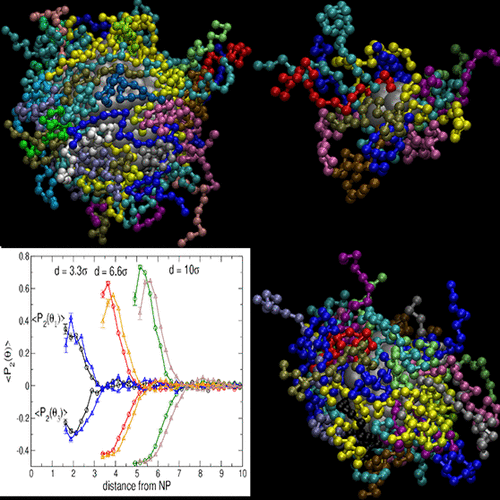当前位置:
X-MOL 学术
›
Macromolecules
›
论文详情
Our official English website, www.x-mol.net, welcomes your feedback! (Note: you will need to create a separate account there.)
Structural Properties of Bound Layer in Polymer–Nanoparticle Composites
Macromolecules ( IF 5.5 ) Pub Date : 2020-09-11 , DOI: 10.1021/acs.macromol.0c01465 Hamed Emamy 1, 2 , Sanat K. Kumar 2 , Francis W. Starr 1
Macromolecules ( IF 5.5 ) Pub Date : 2020-09-11 , DOI: 10.1021/acs.macromol.0c01465 Hamed Emamy 1, 2 , Sanat K. Kumar 2 , Francis W. Starr 1
Affiliation

|
The modification of interfacial polymer behavior is one of the primary sources of property modifications of polymer–nanoparticle (NP) composites (PNC). For strongly favorable polymer–nanoparticle interactions, large NPs exhibit a “bound” polymer layer which has a much longer relaxation time than the surrounding polymer matrix. The difference between the relaxation time of the bound polymer and matrix decreases as the NP size decreases. Using molecular simulations, we explore the degree to which the interfacial polymer structure, and thus the bound layer properties, depends on the size of NP. We find that for larger NPs, chains orient with their longest axis parallel to the NP interface, an effect which diminishes for small NP. We also find that the strength of interfacial interaction does not have a significant effect on the structural changes, which suggests that the change in the polymer chain structure is entropically driven.
中文翻译:

聚合物-纳米颗粒复合材料的结合层的结构特性
界面聚合物行为的改性是聚合物-纳米粒子(NP)复合材料(PNC)进行性能改性的主要来源之一。对于强烈有利的聚合物-纳米颗粒相互作用,大的NP表现出“结合”的聚合物层,其松弛时间比周围的聚合物基质长得多。结合的聚合物和基质的弛豫时间之间的差异随着NP尺寸的减小而减小。使用分子模拟,我们探索了界面聚合物结构以及结合层特性在何种程度上取决于NP的大小。我们发现,对于较大的NP,链的最长轴平行于NP界面定向,对于较小的NP效果减弱。我们还发现界面相互作用的强度对结构变化没有显着影响,
更新日期:2020-09-22
中文翻译:

聚合物-纳米颗粒复合材料的结合层的结构特性
界面聚合物行为的改性是聚合物-纳米粒子(NP)复合材料(PNC)进行性能改性的主要来源之一。对于强烈有利的聚合物-纳米颗粒相互作用,大的NP表现出“结合”的聚合物层,其松弛时间比周围的聚合物基质长得多。结合的聚合物和基质的弛豫时间之间的差异随着NP尺寸的减小而减小。使用分子模拟,我们探索了界面聚合物结构以及结合层特性在何种程度上取决于NP的大小。我们发现,对于较大的NP,链的最长轴平行于NP界面定向,对于较小的NP效果减弱。我们还发现界面相互作用的强度对结构变化没有显着影响,



























 京公网安备 11010802027423号
京公网安备 11010802027423号